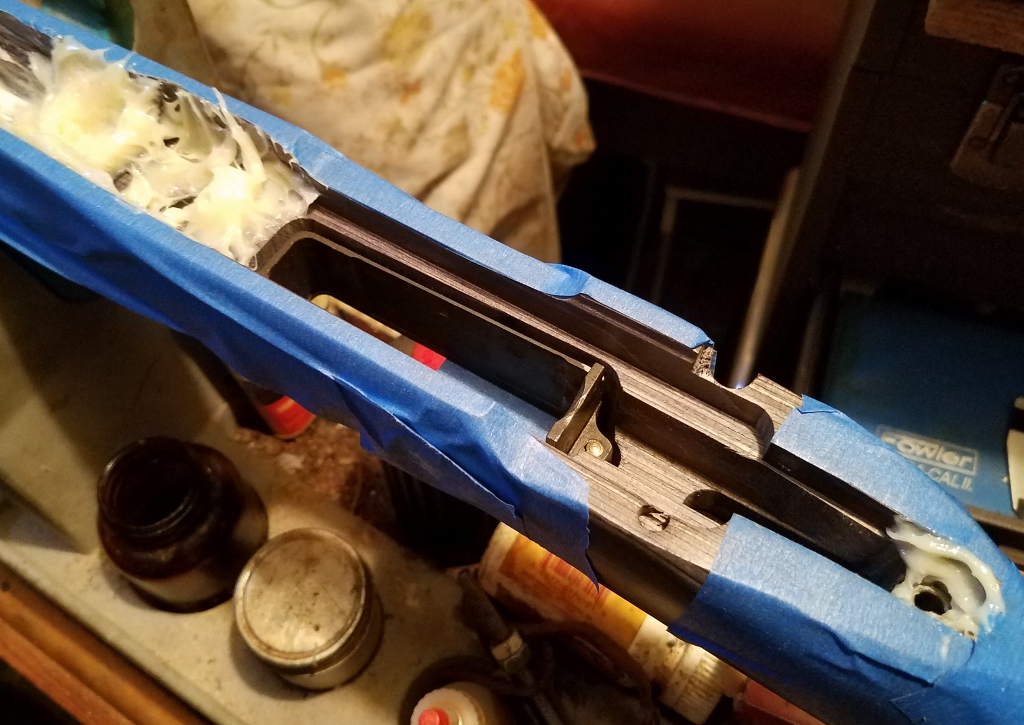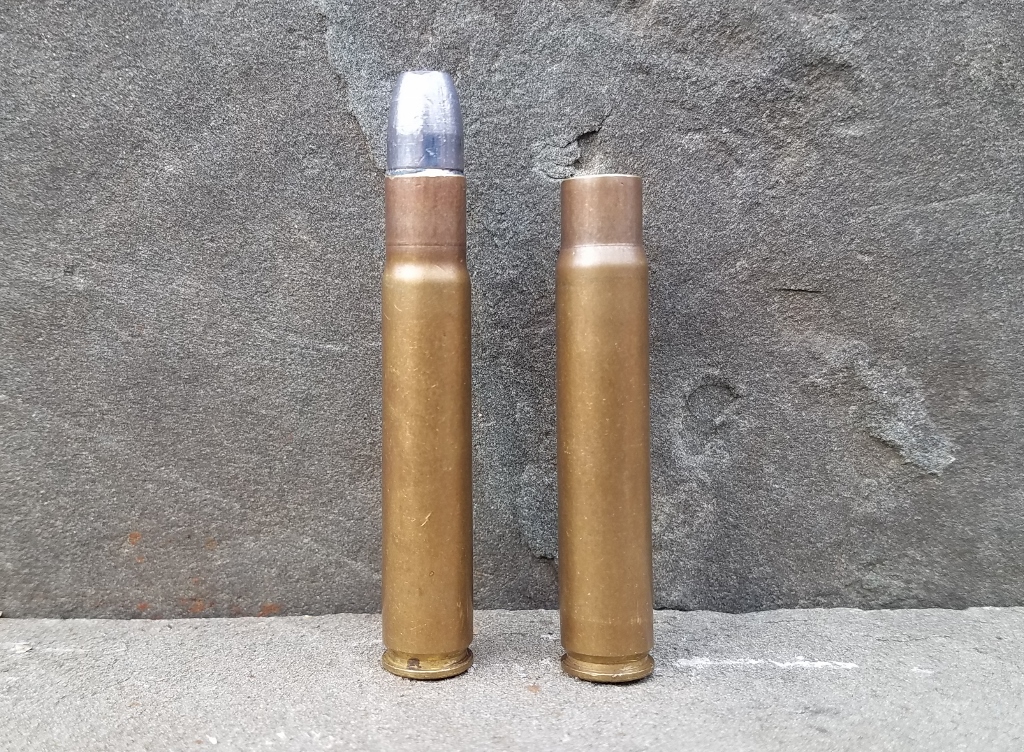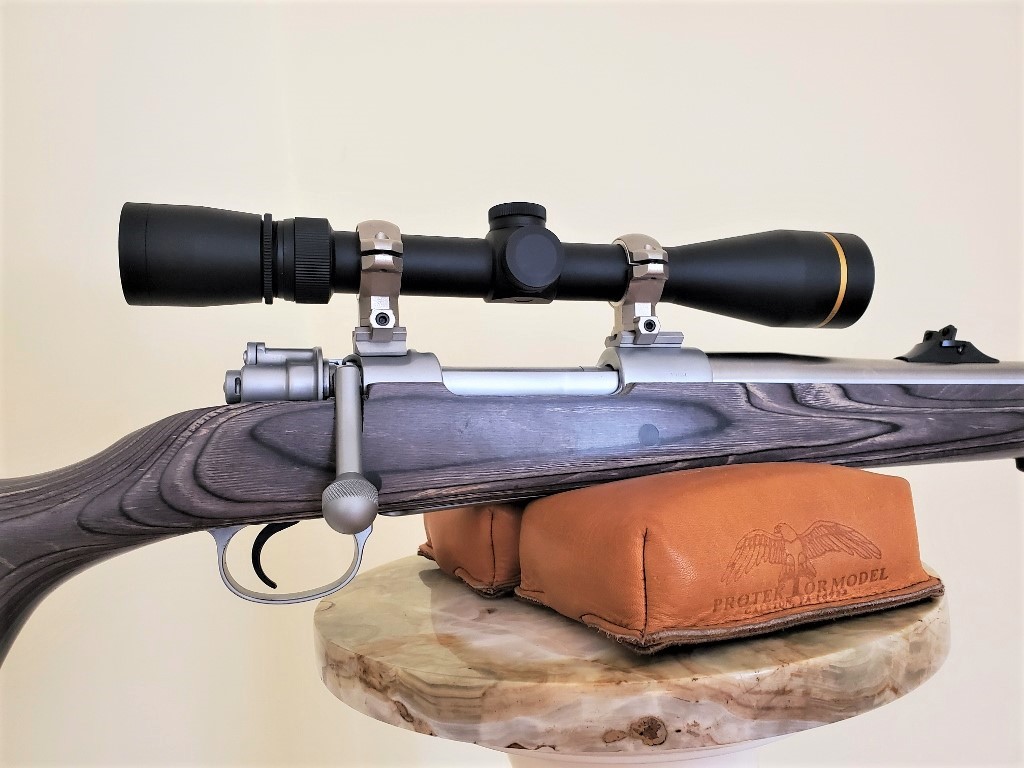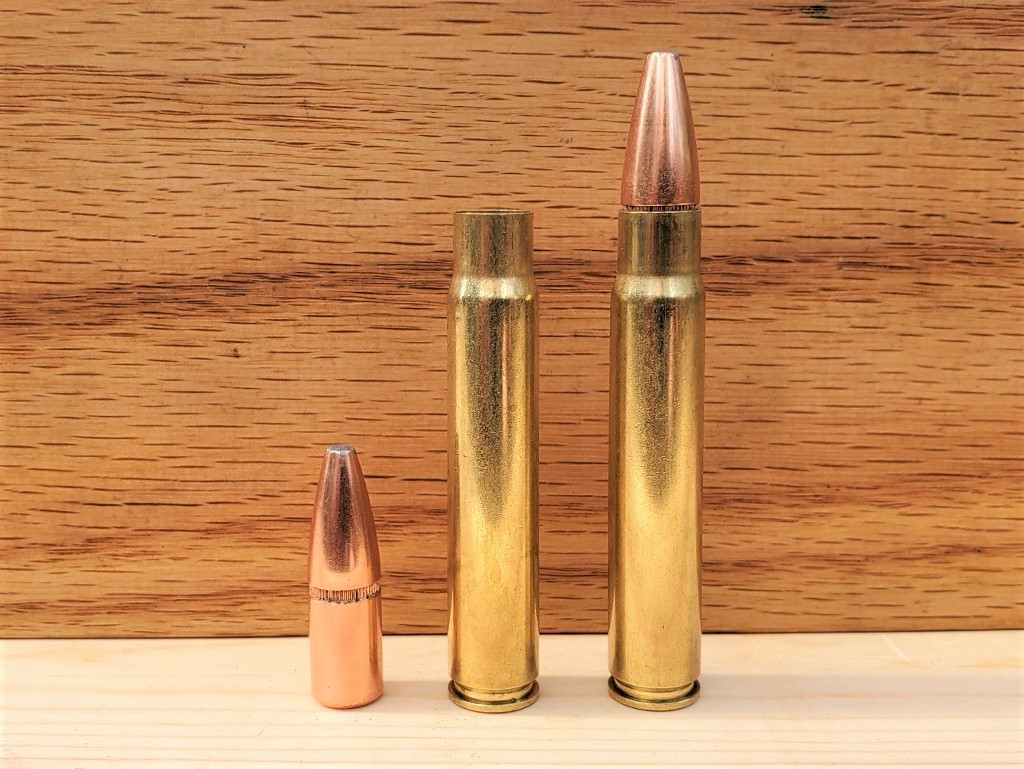|
|
Post by Lee Martin on Dec 9, 2019 20:00:06 GMT -5
Bedding the barreled action – step 1 was to install a steel pillar around the rear action bolt. We machined it to fit between the underside of the receiver and the bottom metal. It was also bored so the bolt doesn’t contact the inner diameter. The entire pillar was epoxied into stock. This required enlarging the stock hole with a drill.  Acraglas Gel was mixed 1:1 epoxy/hardener and globbed into the recoil lug area, rear tang, and about 1” ahead of the main ring. Unlike benchrest guns, we don’t completely free-float the barrel. I like 1- 2” past the tenon. Mausers don’t have the girth and long thread support found on precision actions.  Wax was smeared on the bottom metal, underside of the barrel, bolts, and bolt holes prior to fitting. This served as the release agent. Blue tape masked the wood to catch overflow. Once set in the stock, we used large t-handle screws to pull it down.  -Lee www.singleactions.com"Chasing perfection five shots at a time |
|
|
|
Post by bradshaw on Dec 10, 2019 11:34:44 GMT -5
Lee.... look forward to photos of finished bedding. That Accraglass looks to have a pinch of flock mixed in, and wavy as high tide coming in on the coast of Maine.
with this photo essay you have brought Mauser fans out of the woodwork. Speaking of which, and for the benefit of persons new to the Mauser, the Mauser tang is inletted into the stock. Unlike the tang of a Remington M700, it does not sit on the stock. Traditionally, the rear of the tang does not touch wood; there is a small gap to prevent the stock splitting at the top of the grip. Glass bedding should prevent splitting. Without the bedding, the rear of a tang which contacts the small of the stock acts as a secondary recoil lug. Given any flex, it splits the wood.
David Bradshaw
|
|
|
|
Post by singleaction on Dec 10, 2019 12:01:08 GMT -5
How much much do expect this rifle will weigh?
|
|
|
|
Post by Lee Martin on Dec 23, 2019 18:58:31 GMT -5
I tested the gun today using fire-form loads my dad put together. Both of us will use Hornady 9.3x62 brass, but he wanted to make some from .30-06. That process entails expanding the neck, trimming to length, then firing them to finalize the shoulder. This load consisted of 12.0 grs of Unique with a 250 gr lead bullet. Originally cast as a .375” for the old .38-55, we swaged them to 0.366” w/gas check.  When I got home, we decided to drill and tap the action for Weaver bases. The receiver is now ready to go to Mahovsky’s for Metalife hard-chroming.  -Lee www.singleactions.com"Chasing perfection five shots at a time" |
|
|
|
Post by bushog on Dec 23, 2019 20:58:04 GMT -5
This load consisted of 12.0 grs of Unique with a 250 gr lead bullet. Originally cast as a .375” for the old .38-55, we swaged them to 0.366” w/gas check. -Lee www.singleactions.com"Chasing perfection five shots at a time" I've always wanted to shoot some cast bullets out of mine! Can you size down cast for a .375 H&H? |
|
|
|
Post by Frank V on Dec 30, 2019 16:15:12 GMT -5
Wow love nice builds, the 9.3X62 is a very capable ctg. A friend has a 9.3X74R I've shot some it's a fun ctg.
I'm going to follow this.
|
|
|
|
Post by Lee Martin on Dec 31, 2019 16:09:38 GMT -5
I've always wanted to shoot some cast bullets out of mine! Can you size down cast for a .375 H&H? Yes, you can easily swage .375" bullets to .366". That's what I did on those shown above. -Lee www.singleactions.com"Chasing perfection five shots at a time" |
|
|
|
Post by Lee Martin on Dec 31, 2019 16:11:12 GMT -5
We tied off a couple of loose ends prior to sending the action to Mahovsky’s for hard-chroming. One thing I’ve been fighting is tight bolt pull as it enters the rear portion of the receiver. Using red marking paint, we found the extractor was rubbing against the right inner wall. The extractor was smoothed on a belt sander, but there was still a hint of drag. We then took a truing mandrel wrapped with sand paper to polish the lug slots. This was followed by coating the extractor with lapping compound and working the bolt back and forth a few hundred times.  The scope bases were then checked with a leveling guide. The back edge of the tang-side mount was low. Remember, these old 98’s were forged and never intended for scope mounting. It’s quite common to find uneven spots across both bridges. A steel shim was cut and hole punched with a Roper Whitney tool.  The shim was placed under the mount and scribed for cutting. Both bases are now dead parallel. Shim prior to scribing and cutting.  -Lee www.singleactions.com"Chasing perfection five shots at a time" |
|
|
|
Post by bradshaw on Dec 31, 2019 20:08:45 GMT -5
Lee.... fascinating, the disparity on receiver bridge. Did you measure via dial indicator or shims? I haven’t encountered such disparity on FN or Husqvarna commercial 98’s. Which isn’t to say it doesn’t happen. And, neat hole punch.
David Bradshaw`
|
|
|
|
Post by z1r on Jan 1, 2020 0:19:27 GMT -5
Lee.... fascinating, the disparity on receiver bridge. Did you measure via dial indicator or shims? I haven’t encountered such disparity on FN or Husqvarna commercial 98’s. Which isn’t to say it doesn’t happen. And, neat hole punch. David Bradshaw` The FN actions, which by the way were used in the Husqvarna as well, were built with scope mounting in mind and therefore more care was given to ensure the bridge and front ring dimensions were consistent. As Lee pointed out, the military receivers were not made with scope mounting in mind. Additionally, the 98 action was made by many different manufacturers to specs that varied somewhat depending on the contract. I dealt with this issue by recontouring the rear bridge. This way I could set the height of the bridge to a level that matched the scope bases I intended to mount. Sometimes, especially if the front ring had been ground, you might not be able to grind enough off the rear bridge to sort it out without leaving the bridge too thin over the guide rib tunnel. In those cases, I recut the rear scope base as needed.    In this case, I suspect the front of that scope base may be riding up on the curve at the rear of the stripper clip guide (Charger Hump). If, so, radiusing the front edge of the base may allow it to sit level. |
|
|
|
Post by bradshaw on Jan 1, 2020 8:56:49 GMT -5
"The FN actions, which by the way were used in the Husqvarna as well, were built with scope mounting in mind and therefore more care was given to ensure the bridge and front ring dimensions were consistent.”
----z1r
*****
z1r.... Husqvarna 98’s of my acquaintance are Swedish commercial, with small receiver ring and Model 70 style ejector slot under left locking lug. Great rifles, my favorite of all the 98’s. With, incidentally, the best contour semi-pistol grip ever put on a woods rifle.
David Bradshaw
|
|
|
|
Post by z1r on Jan 1, 2020 12:17:59 GMT -5
Mr. Bradshaw, prior to the introduction of the Husqvarna made modified 98 actions, they used FN Made 98 actions. First, Military style receivers with the thumbcut on the left side wall, then around 1948-9 they switched to the Commercial Style 98 action.
Coincidentally, one of my favorite Husqvarna 1640 rifles is chambered in 9,3x62. I agree, the Husqvarna stocks were some of the best shaped factory stocks made. Nice grips, a little cast, and even some toe. They shoulder beautifully!
|
|
|
|
Post by singleaction on Jan 4, 2020 14:11:34 GMT -5
The 1640 is the best fitting open sight rifle I have ever shouldered. I can pull the gun up with my eyes closed, and it’s ready to go when eyes open. Everyone is built different, so finding that perfect fit is hard. The 1640 just does it for me. The previous gens of Husky rifles are nice, but I have to scrunch my shoulders and neck down a little to align the sights.
|
|
|
|
Post by Lee Martin on Apr 16, 2020 19:30:01 GMT -5
My action came back from Mahovsky’s and the gun is finally together. It isn't fancy. I wanted simple, clean aesthetics. But..... • The barrel is match grade Shilen indexed on every groove and land. • The action is blueprinted top to bottom. • The bedding job is dead on. I chose a Leupold VX-3i 3.5-10x40mm with duplex reticle.  A Timney trigger was installed and set to 2 lbs.  The barrel is 24” and topped with NECG’s fully adjustable rear behind their masterpiece front ramp w/gold bead.   I’ll see how it shoots this Saturday. Shown below - a full case of AA4350 with Hornady’s 286 gr Interlock. It should clock 2,350 to 2,400 fps.  -Lee www.singleactions.com"Chasing perfection five shots at a time" |
|
|
|
Post by Cholla on Apr 16, 2020 21:56:22 GMT -5
Beautiful rifle and excellent work and write up. Hope to see some targets soon. This is my favorite 9.3x62 (except for the hideous orange front sight insert that the 'smith decided needed to be there).   |
|